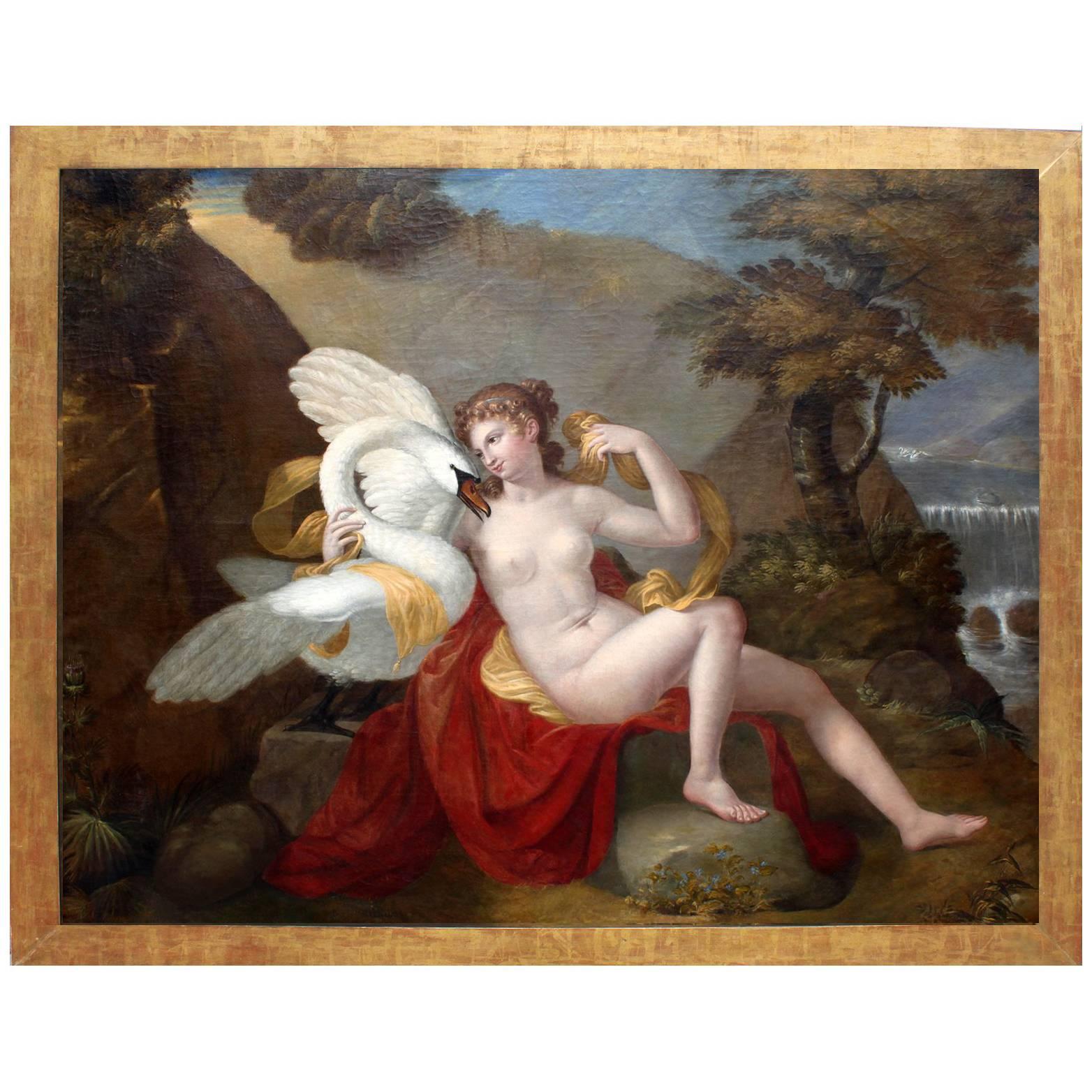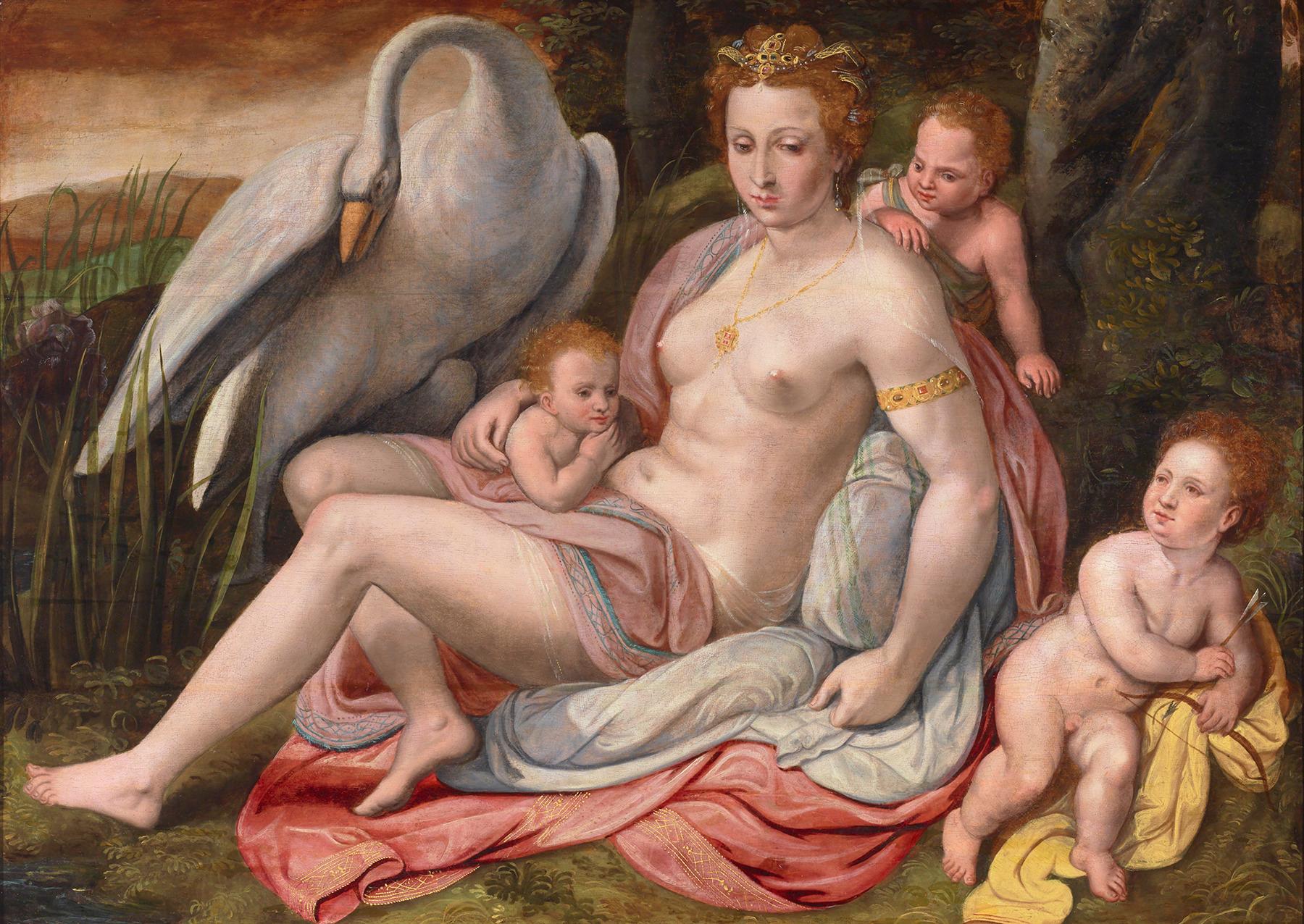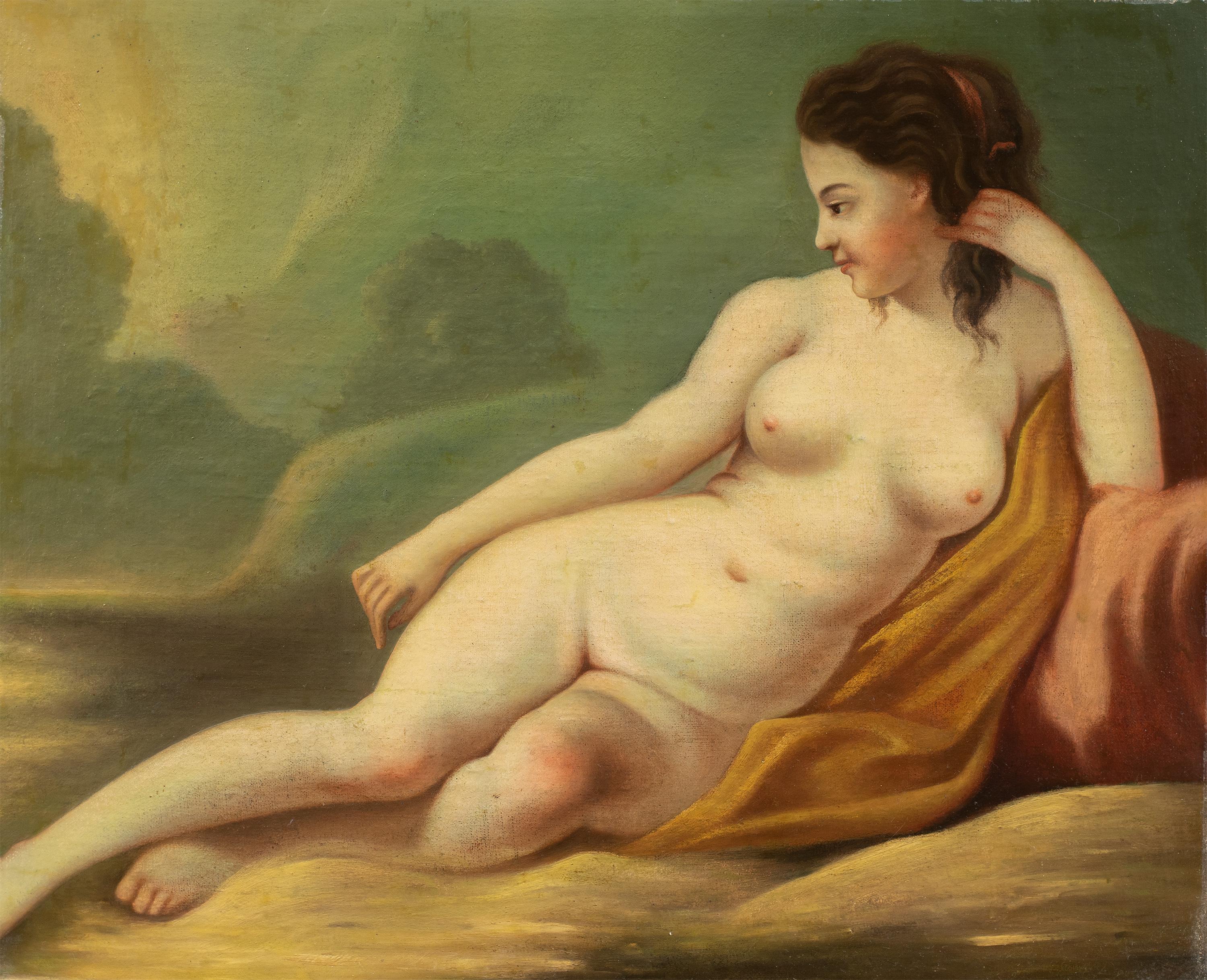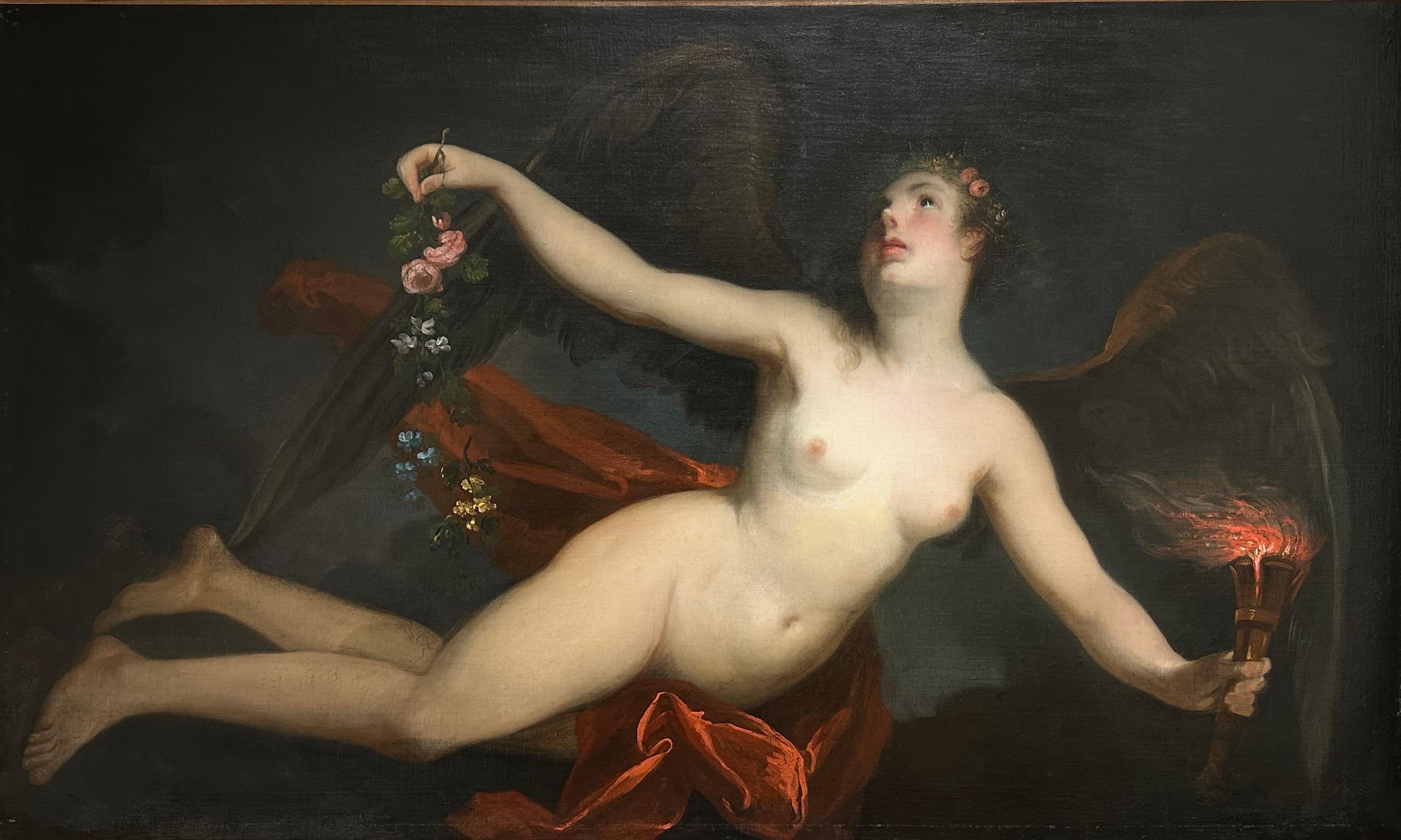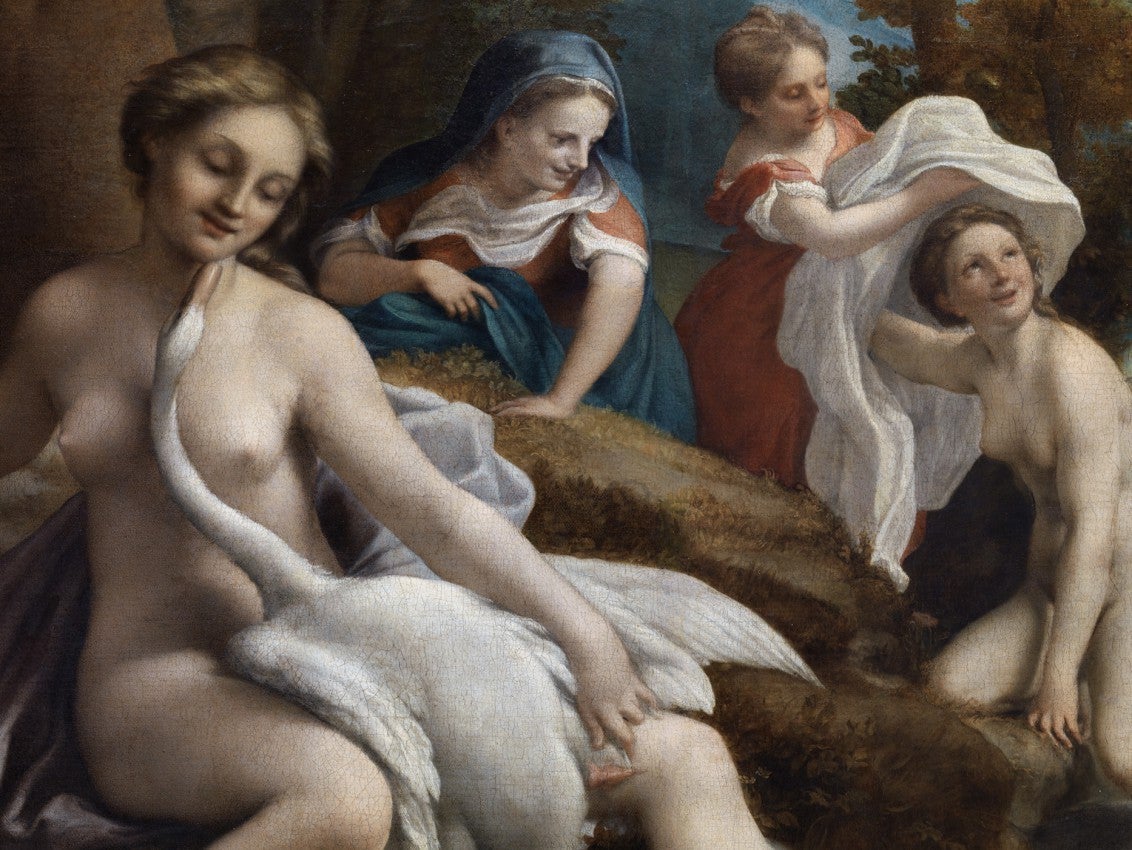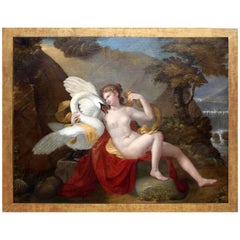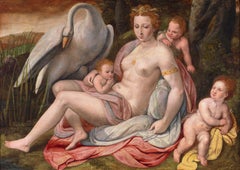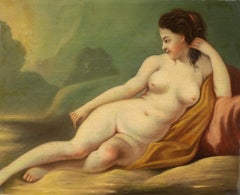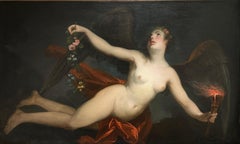Items Similar to Leda Swan Mythological Paint oil on canvas French Painter 18th Century
Video Loading
Want more images or videos?
Request additional images or videos from the seller
1 of 19
Leda Swan Mythological Paint oil on canvas French Painter 18th Century1780-1840
1780-1840
$11,611.71
$14,514.6420% Off
£8,655.73
£10,819.6620% Off
€9,776
€12,22020% Off
CA$16,185.10
CA$20,231.3720% Off
A$17,590.41
A$21,988.0220% Off
CHF 9,295.85
CHF 11,619.8120% Off
MX$212,806.06
MX$266,007.5720% Off
NOK 115,773.15
NOK 144,716.4320% Off
SEK 109,354.94
SEK 136,693.6720% Off
DKK 74,448.68
DKK 93,060.8520% Off
About the Item
French painter of the late 18th-early 19th century
Leda and the Swan (Literary source: Metamorphoses by Ovid, Book VI)
Oil on canvas 95 x 126 cm Framed 109 x 142 cm
This charming painting, originally intended to adorn the rooms of a private residence, depicts the beautiful Leda, queen of Sparta and wife of King Tyndareus, victim of Zeus' deception. According to the myth, the King of the Gods fell madly in love with her and decided to win her over, but in order to approach her without arousing suspicion, he took the form of a magnificent swan, taking advantage of her vulnerability while she was resting on the banks of the river Eurotas.
The queen, struck by the beauty of the swan, welcomed him into her arms, thus ending up being seduced by Zeus, who joined her: from the encounter, desired by both parties, an egg was born, from which her children Helen and Pollux came into the world.
In Greek mythology, Leda and the Swan is undoubtedly one of the most fascinating stories, inspiring many artists since the Renaissance, with depictions full of eros, where the fusion between the human and the divine is manifested in sensual and ambiguous forms.
In the past, this subject was also attributed great symbolic value, often identified as an allegory of carnal love, and more specifically, the success of this iconography was linked to the transferred image of the coupling between man and woman, covered by the allegory of the myth.
Finally, as regards attribution, this is a splendid work that can be linked to a romantic artist, presumably French, active between the 18th and 19th centuries, who was able to treat this mythological theme with a sensual image of nudity. In the 18th century, with Neoclassicism, thanks to artists such as Jacques-Louis David, there was a growing interest in the artistic nude, a celebration of ideal beauty, and the representation of the female body gave paintings such as this one an intense and sensual atmosphere.
Moving on to the 19th century, nude poses, perhaps combined, as in our case, with pleasant mythological subjects, achieved particularly appreciated results. In France in particular, women painted through the realism of their bodies conveyed their sensual physicality, such as the models of Courbet and Ingres, modelling them according to the canons of beauty of classical nudes.
ADDITIONAL INFORMATION:
The painting is sold complete with a beautiful 19th-century gilded frame and comes with a certificate of authenticity and a descriptive iconographic card.
We take care of and organise the transport of purchased works, both in Italy and abroad, through professional and insured carriers.
If you would like to see this or other works in person, we would be delighted to welcome you to our new gallery in Riva del Garda, at Viale Giuseppe Canella 18. We look forward to seeing you!
Please contact us for any information or to arrange a visit, we will be happy to assist you.
- Attributed to:French Painter Of The Late 18th
- Creation Year:1780-1840
- Dimensions:Height: 42.92 in (109 cm)Width: 55.91 in (142 cm)
- Medium:
- Movement & Style:
- Period:
- Condition:
- Gallery Location:Riva del Garda, IT
- Reference Number:1stDibs: LU988116189982
About the Seller
4.9
Platinum Seller
Premium sellers with a 4.7+ rating and 24-hour response times
Established in 2017
1stDibs seller since 2018
263 sales on 1stDibs
Typical response time: 2 hours
- ShippingRetrieving quote...Shipping from: Riva del Garda, Italy
- Return Policy
Authenticity Guarantee
In the unlikely event there’s an issue with an item’s authenticity, contact us within 1 year for a full refund. DetailsMoney-Back Guarantee
If your item is not as described, is damaged in transit, or does not arrive, contact us within 7 days for a full refund. Details24-Hour Cancellation
You have a 24-hour grace period in which to reconsider your purchase, with no questions asked.Vetted Professional Sellers
Our world-class sellers must adhere to strict standards for service and quality, maintaining the integrity of our listings.Price-Match Guarantee
If you find that a seller listed the same item for a lower price elsewhere, we’ll match it.Trusted Global Delivery
Our best-in-class carrier network provides specialized shipping options worldwide, including custom delivery.More From This Seller
View AllVenus Paolo Fiammingo Paint Oil on canvas Old master 16th Century Italian Art
Located in Riva del Garda, IT
Pauwels Franck, known as Paolo Fiammingo
(Antwerp, 1540 - Venice, 1596)
Venus lying in a landscape
Oil on canvas 116 x 150 cm.
In antique frame 136 x 170 cm.
The work is accompanied by a critical card by Dr. Federica Spadotto
The splendid painting proposed sees portrayed, bare and stretched out on a red brocade cloth in gold sprinkled with roses, a refined and sensual Venus, in a composition with a profound symbolic value, and arriving at the perfect representation of the Renaissance woman who, like Venus, becomes an allegory love, eros, beauty and fertility.
The canvas is part of the prestigious Venetian artistic and cultural environment of the second half of the sixteenth century, whose distinctive distinctive trait can be traced back to its cosmopolitan vocation. This characteristic, as Dr. Spadotto noted in her in-depth study, belongs to the same physiology of the Venetian capital, that is, being a distinctly commercial city located in a strategic point with respect to trade. Representing one of the liveliest ports in the Mediterranean also meant witnessing the continuous passage not only of goods, but of men, ideas, suggestions from distant countries, which influenced not only the taste of their people, but above all art.
This happened thanks to the circulation of prints, as well as pictorial specimens, to which are added the stays of great foreign artists and, above all, the permanence in the capital of a non-negligible number of Dutch, Flemish and German masters.
An emblematic case in this regard comes from Pauwels Franck (Antwerp, 1540 - Venice, 1596), better known as Paolo Fiammingo, who established himself in his native city at a young age - in 1561 a figure enrolled in the Guild of San Luca - and arrived in Venice in 1573. .
He resided in Venice from 1584 until his death, although the stylistic and formal references of some of his works have led critics to believe that in previous years he had undertaken a journey to central Italy, or to Florence and Rome, where he would have metabolized the lively cultural debate that permeated these cities and which, on the other hand, seemed completely absent in Venice.
Here Paolo will be fascinated by the sense of color and by the atmospheric component fixed on the canvas by Jacopo Tintoretto (Venice 1518 - 1594), of which he becomes a collaborator, to undergo, around 1590, the suggestion of Paolo Caliari...
Category
16th Century Old Masters Paintings
Materials
Oil
$30,264 Sale Price
30% Off
Venus Cupid 17/18th Century Paint Oil on canvas Old master Venetian school
Located in Riva del Garda, IT
Venetian painter of the 17th/18th century
Venus and Cupid
Oil on canvas 57 x 49 cm. In frame 71 x 61 cm.
The painting captures the attention with its intimate and sensual re...
Category
17th Century Old Masters Paintings
Materials
Oil
$5,558 Sale Price
20% Off
Jupiter Antiope Van Dyck Mythological Paint 17/18th Centuty Oil on canvas Art
Located in Riva del Garda, IT
Anthoon van Dyck (Antwerp 1599 - London 1641) follower
Large canvas depicting ‘The Myth of Jupiter and Antiope’
(Ovid's Meramorphoses, Book VI)
Oil on canvas
116 x 150 cm. - with f...
Category
17th Century Old Masters Paintings
Materials
Oil
$17,294 Sale Price
20% Off
Toilet Venus Albani Mythological 17/18th Century Paint Oil on canvas Old master
Located in Riva del Garda, IT
Toilet of Venus Francesco Albani (Bologna 1578 - 1660) Follower of
Oil on canvas 64 x 96 cm In fine gilded frame 83 x 121 cm.
The painting on offer, depicting ‘Venus’ Toilet',...
Category
17th Century Old Masters Paintings
Materials
Oil
$9,511 Sale Price
20% Off
Diana Boullogne Mythological Paint Oil on canvas old master 17/18th Century
Located in Riva del Garda, IT
Bon Boullogne (Paris, 1649 - Paris, 1717) workshop of
Episodes from the myth of Diana
oil painting on canvas
Dimensions: 84 x 114 cm.
with antique frame 100 x 132 cm.
The beautiful painting proposed shows a series of episodes taken from the myth of the divinity Diana, the Roman divinity of hunting, forests and wild animals, masterfully captured in this valuable painting, which shows a luxuriant wood, a favorite place of the divinity, as a theater of his adventures.
The composition opens, on the left, with a sort of presentation of the divinity, portrayed as an attractive young girl, surrounded by her faithful Nymphs, one of whom holds her quiver with arrows, and by one of her beloved dogs. hunting her.
The 'story' continues in the central part where we can see the divinity during a wild boar hunt...
Category
Late 17th Century Old Masters Paintings
Materials
Oil
$8,384 Sale Price
20% Off
Venus Love Guercino 17th Century Paint Oil on canvas Old master Emilian school
Located in Riva del Garda, IT
Giovanni Francesco Barbieri, the Guercino (Cento 1591 - Bologna 1666), workshop
Attributable to, Benedetto Gennari (Cento, 1633 - Bologna, 1715)
Venus disarming Love
oil on canvas
...
Category
17th Century Old Masters Paintings
Materials
Oil
$10,870 Sale Price
20% Off
You May Also Like
French 19th Century Old Master School Oil on Canvas Titled "Leda and The Swan"
Located in Los Angeles, CA
A fine and large French 19th century old master school oil on canvas titled "Leda and The Swan" within a giltwood frame. Leda and the swan is a motif from Greek mythology, in which Z...
Category
Antique 19th Century French Renaissance Revival Paintings
Materials
Giltwood, Canvas
$49,850 Sale Price
40% Off
Leda And The Swan By Workshop Of Bartholomaeus Spranger
Located in New Orleans, LA
Workshop of Bartholomaeus Spranger
16th Century Flemish
Leda and the Swan
Oil on panel
Retelling one of the most legendary Greco-Roman mythological tales, this exceptional oil on...
Category
16th Century Old Masters Nude Paintings
Materials
Oil, Panel
Rococò Italian painter - 18th/19th century figure painting - Nude female
Located in Varmo, IT
Italian painter (18th-19th century) - Female nude.
44 x 54 cm without frame, 54 x 64 cm with frame.
Antique oil painting on canvas mounted on a panel, in a carved and gilded wooden...
Category
Late 18th Century Rococo Figurative Paintings
Materials
Canvas, Oil
$1,781 Sale Price
40% Off
Free Shipping
Huge 18th Century French Rococo Old Master Oil Allegorical Nude Winged Lady
Located in Cirencester, Gloucestershire
The Allegorical Winged Nude Lady, adorned with the attributes of Spring
French School, 18th century (Rococo period)
oil painting on canvas, unframed
canvas: 30 x 52 inches
provenance...
Category
18th Century Rococo Figurative Paintings
Materials
Oil, Canvas
$8,483 Sale Price
20% Off
Reinhard Görner – Leda with Swan, 1532, Correggio – Painting Detail Photograph
By Reinhard Görner
Located in Los Angeles, CA
Reinhard Görner’s Leda with Swan unveils an intimate and evocative perspective on Correggio’s 16th-century masterpiece, capturing the painter’s exquisite handling of light, texture, ...
Category
Early 2000s Conceptual Figurative Photography
Materials
Lambda
Reinhard Görner – Leda with Swan, 1532, Correggio – Painting Detail Photograph
By Reinhard Görner
Located in Los Angeles, CA
Reinhard Görner’s Leda with Swan unveils an intimate and evocative perspective on Correggio’s 16th-century masterpiece, capturing the painter’s exquisite handling of light, texture, ...
Category
Early 2000s Conceptual Figurative Photography
Materials
Lambda
More Ways To Browse
18th And 19th Century Paintings
18th Century Canvas
Antique Transfers
Old Master Paintings Of Children
18th Century French Art
18th Century French Paintings
19th Century Oil Painting Of Women
18th And 19th Century Oil Paintings
Italian Oil Painting Old Man
Swan Painting
Antique Canon
Antique Canons
Oil Painting Of A Swan
18th Century Oil Painting Woman
Nude Oil Painting 19th Century
18th French Oil Painting
Old Man Oil Painting 19th Century
French Old Master
